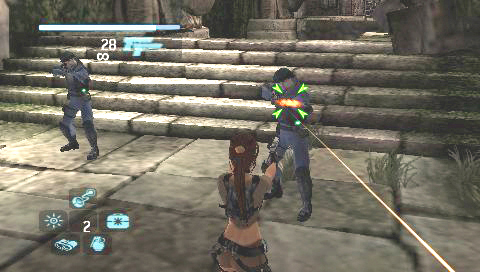
They say sex sells, but the Tomb Raider games are proof that not everyone lets their genitals do the shopping. With each outing of virtual archaeologist Lara Croft further diluting the essence that made the 1996 original so desirable, not even then-developer Core Design's obsession with increasing Lara's bra cup size convinced players to stick with the gradually weaker series. There may be some video game franchises that have been more systematically exploited than Tomb Raider, but our ageing brains can't think of any.
Thankfully, Legend marks something of a return to form. Now under the creative control of Crystal Dynamics, the focus is back on tomb raiding across the world's vine-covered temples, with most of your time spent scaling ruins, avoiding ancient bone crushing and spine severing traps, and solving admittedly-obvious-though-nevertheless-satisfying archaeological brainteasers, as you strive to get Lara's mysteriously callous-free hands on whatever the little minx has set her gorgeous brown eyes on.
Whether it's rock climbing, hanging off ledges, swinging on ropes or poles, jumping over wide chasms or swimming through narrow ruins desperately looking for the opportunity for your next breath of air, Lara negotiates the many obstacles in her path with a satisfying fluidity, matched by the quality of the animation of her actions.
Calmly working out and successfully negotiating the convoluted route to a platform high above the ground is often the most enjoyable aspect of the game, followed closely by solving the many puzzles you encounter – indeed, the two are often intrinsically linked. And because money is no object when you're an aristocratic thief, Lara has a selection of neat toys at her disposal, the most useful of which is her grapple gun enabling her to pull down obstacles or swing across to safety (helpfully, grapple points are indicated by icons due to their position off-screen).
Pleasing, too, is the introduction of established concepts such as Quick Time events (requiring you to press highlighted buttons during a tense, action-paced sequence), which further round out the gaming experience.
You'll also find things to shoot. These tend to be mainly trigger happy (yet reckless) henchmen, though Lara is equally at ease gunning down members of endangered species (we suspect stealing sacred relics for a living demands a certain moral flexibility).
Still, conservationists would no doubt be proud of the animals' ability to present the more dangerous opposition, even if, unlike Lara's human adversaries, they can't carry machine guns or shotguns. The latter can be picked up from downed minions to take over from the archaeologist's trusty, though weaker, twin pistols, and you'll also find grenades, though we found their use too cumbersome in practice.
But that's not too problematic; once you factor in the mostly functional, repetitive nature of Legend's shootouts, it's easiest to regard these segments as simple diversions from the game's core dynamic of artefact pocketing.
More disappointing is to find some of the controls spoiling the fun. The analogue stick input is too wild and twitchy for precise on-foot control (and utterly useless during the fast moving motorbike sections) which can result in some unpredictable jump angles, the manual camera override – while neatly making double use of the analogue stick (by holding down Square) – feels a little convoluted, and there's a subtle yet noticeable lag to some commands, which can grate.
Equally of concern is the way the game has a tendency to nanny you through events, occasionally removing the sense of challenge and, with it, some of the classic Tomb Raider atmosphere.
You do get used to most of these issues, but then you'll probably start to pick on the game's technical shortcomings. While this is essentially identical to the home console versions, featuring the same excellent level design and production values (not least the atmospheric soundtrack), the visuals have had to be toned down. They remain impressive – the sense of scale when entering a vast chamber of a new tomb is certainly conveyed – but at the expense of the frame rate. At times the PSP struggles to cope, resulting in an unpleasantly juddering experience.
Happily, handheld owners get some recompense. Legend's Tomb Trial mode, exclusive to Sony's handheld, features single or wi-fi head-to-head time trial and artefact collecting challenges, and it makes for a solid, substantial addition, which builds on some of the main game's most fun elements.
And that's probably how you'll remember the first PSP Tomb Raider – its engaging plot, unusual pace, atmosphere, inventive touches, various play modes and the fresh mix of concepts ultimately prove very seductive.
Lara Croft Tomb Raider Legend is out now – click here to buy.
Lara Croft Tomb Raider: Legend

